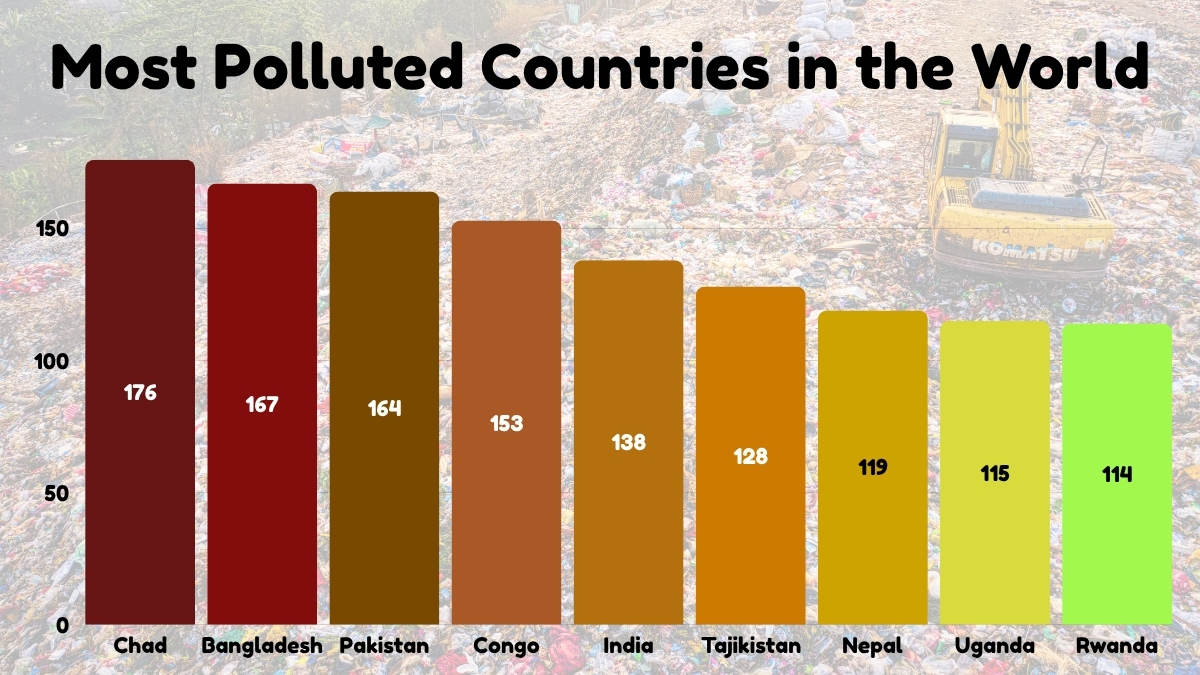Key Points
- Chad currently ranks highest due to vehicle emissions, dust storms and biomass burning.
- Pollution is primarily measured by Air Quality Index (AQI) and PM2.5/PM10 particulate levels, indicating harmful pollutants in the air.
- Pollution increases risks of asthma, respiratory diseases, and lowers life expectancy, especially for vulnerable groups.
Polluted Countries in the World: Chad tops the list of 9 Most Polluted Countries by its Air Quality Index score. Air pollution is a growing global challenge, impacting millions across continents in 2025.
The air quality is worsening due to 3 three main reasons- industrialization, urban traffic, and agricultural practices. People in some countries breathe air far more harmful than the global standard. Governments are taking measures, yet pollution remains stubbornly high.
Understanding which nations are most impacted is crucial for future solutions and international cooperation. This article presents current rankings for the 9 most polluted countries in the world, explores pollution’s main causes, and explains the consequences for public health.

List of 9 Most Polluted Countries in the World
The countries listed below consistently rank among the most polluted countries in the world. Each faces unique challenges, impacting air quality and health through various sources and environmental factors.
| Rank | Country | Air Quality Index+ | PM2.5 Legend | Main Pollution Sources |
| 1 | Chad | 176 | 91.8 | Dust storms, biomass burning |
| 2 | 167 | 78 | Brick kilns, traffic, waste burning | |
| 3 | Pakistan | 164 | 73.7 | Traffic, industry, crop burning |
| 4 | Democratic Republic of Congo | 153 | 58.2 | Industry, burning, agriculture |
| 5 | India | 138 | 50.6 | Vehicles, industry, crop burning |
| 6 | Tajikistan | 128 | 46.3 | Vehicles, industrial activities and residential heating |
| 7 | Nepal | 119 | 42.8 | Urban emissions, crop burning |
| 8 | Uganda | 115 | 41 | Vehicles, industrial activities and biomass burning |
| 9 | Rwanda | 114 | 40.8 | Vehicles, industrial activities and residential heating |
(Source- IQAir World Air Quality)
Chad- World’s Most Polluted Country
With an Air Quality Index of 176, Chad's high pollution is largely driven by environmental factors. The primary sources include widespread dust storms and biomass burning, which contribute to a high PM2.5 concentration of 91.8. This makes Chad the world's most polluted country
Bangladesh
Bangladesh ranks second with an AQI of 167. Its significant PM2.5 level of 78 is primarily a result of human activities, including emissions from brick kilns, dense vehicle traffic, and the burning of domestic and industrial waste.
Pakistan
Ranked third, Pakistan has an Air Quality Index of 164. The nation’s high PM2.5 levels (73.7) are a result of a combination of factors, including vehicular exhaust, industrial emissions, and the seasonal burning of crops.
Read About- How Light Pollution Is Threatening the Very Large Telescopes in Chile?
Pollution Causes and Health Impacts
The most polluted countries suffer from a mix of urban traffic, industry, crop burning, and natural dust storms, elevating dangerous PM2.5 and PM10 levels. Residents face increased risks of lung diseases, asthma, and reduced life expectancy. Pollution is especially harmful to children and the elderly.
Global Responses and Trends
Many governments are expanding electric transport, renewable energy investment, and pollution control laws. Despite progress, rapid population growth and urbanization often outpace improvements. International bodies are calling for urgent cooperation to address pollutants that cross borders and threaten global health.
Must Read- List of the 10 Most Polluted Countries in Asia
Conclusion
The 9 most polluted countries in the world in 2025 highlight the challenge each nation faces in tackling air quality. Though local efforts help, comprehensive, worldwide cooperation and innovation remain essential for cleaner air and healthier populations. Awareness and data-driven policies are key to progress.
To see more of such stories, you can go ahead and add this site to your preferred sources by clicking here.
Comments
All Comments (0)
Join the conversation